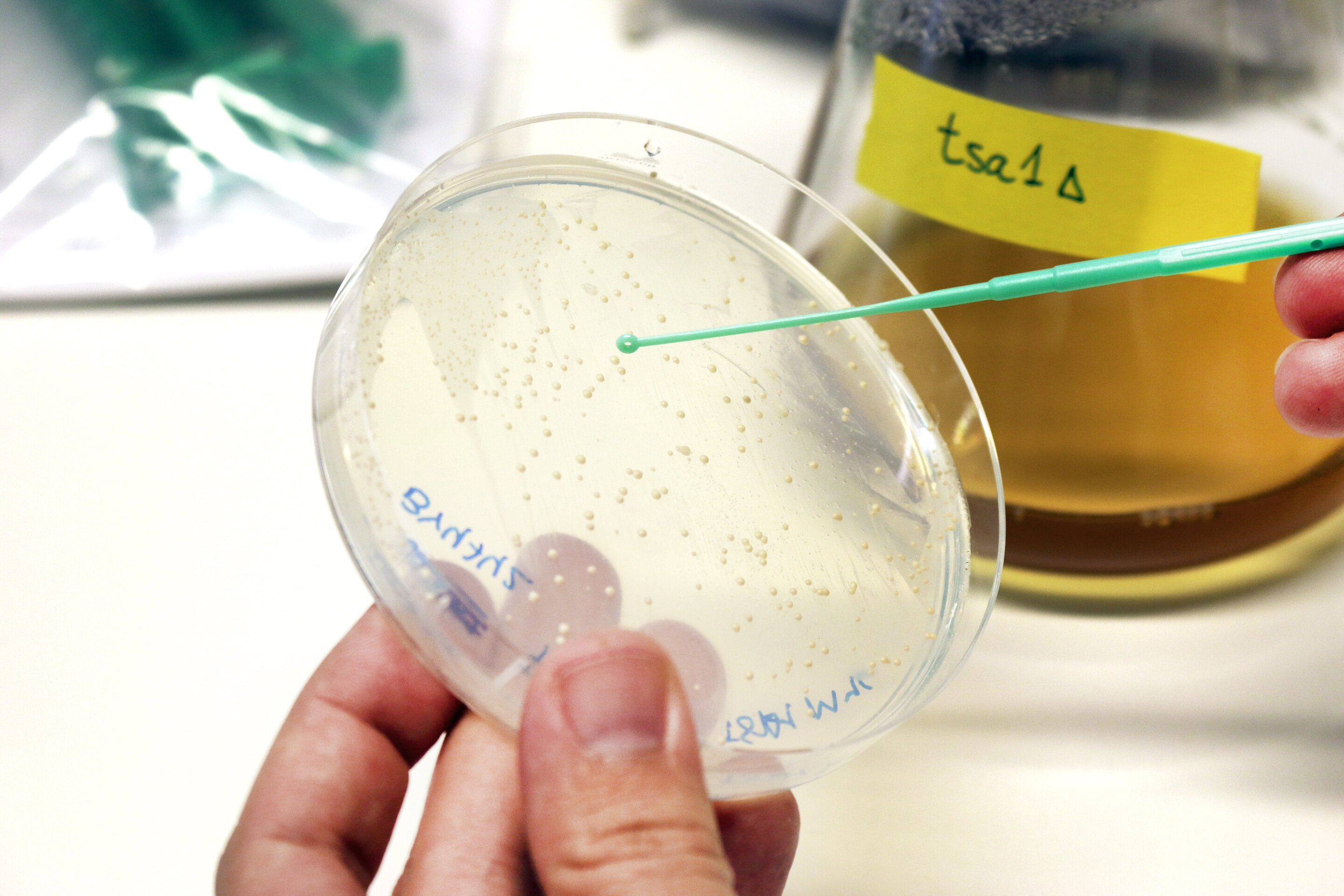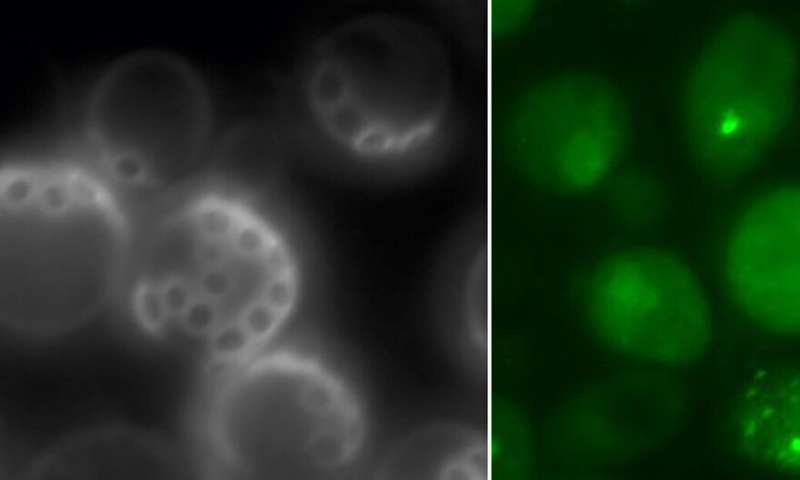
[ad_1]

Yeast can be grown on both solid and liquid nutritional medium and is a good model system for studying aging. Yeast cells share many molecular mechanisms with cells of more complex organisms, but it is easy to change their DNA and study the functions of different genes. Yeast also produces many generations in a short time. Credit: Martina Butorac / Chalmers University of Technology
At high concentrations, reactive oxygen species called oxidants are harmful to cells in all organisms and have been linked with aging. But a study from Chalmers University of Technology in Sweden has now shown that low levels of oxidizing hydrogen peroxide can stimulate an enzyme that helps slow the aging of yeast cells.
One of the benefits of antioxidants, such as vitamins C and E, is that they neutralize reactive oxygen species, called oxidants, which might otherwise react with important molecules in the body and destroy their biological functions. Larger amounts of oxidants can seriously damage DNA, cell membranes and proteins, for example. Our cells have therefore developed powerful defense mechanisms to get rid of these oxidants, which form in our normal metabolism.
It was previously believed that oxidants were only harmful, but recently scientists have started to understand that they also have positive functions. Now, new research from Chalmers University of Technology shows that the well-known oxidizing hydrogen peroxide can actually slow the aging of yeast cells. Hydrogen peroxide is a chemical used for bleaching hair and teeth, among others. It is also one of the metabolically produced oxidants which is harmful at higher concentrations.
Chalmers researchers studied the enzyme Tsa1, which is part of a group of antioxidants called peroxiredoxins.
“Previous studies of these enzymes have shown that they participate in the defenses of yeast cells against harmful oxidants,” explains Mikael Molin, who heads the research group in the Department of Biology and Biological Engineering at Chalmers. “But peroxiredoxins also help extend the lifespan of cells when they are under calorie restriction. The mechanisms behind these functions have not yet been fully understood.”
Researchers know that reduced calorie intake can dramatically extend the lifespan of a variety of organisms, from yeast to monkeys. Several research groups, including that of Mikael Molin, have also shown that stimulating the activity of peroxiredoxin in particular is what slows down the aging of cells in organisms such as yeast, flies and worms, when they receive fewer calories than normal through food.
“Now we have found a new function of Tsa1,” says Cecilia Picazo, postdoctoral researcher in Chalmers’ Systems and Synthetic Biology Division. “Previously, we thought that this enzyme simply neutralized reactive oxygen species. But now we’ve shown that Tsa1 actually requires a certain amount of hydrogen peroxide to be triggered in order to participate in the slowing down aging process. yeast cells. “

Yeast is a good model system for studying aging. Researchers can easily determine the age of cells by counting the scars of buds, formed as they divide and forming new cells as they sprout (left). As yeast cells age, you can examine, for example, how proteins are damaged and aggregated (light spots in the image to the right), a process that in higher organisms can be linked to the degeneration of nerve or brain cells in, for example, Alzheimer’s or Parkinson’s disease. Credit: Mikael Molin / Chalmers University of Technology
Surprisingly, the study shows that Tsa1 does not affect the levels of hydrogen peroxide in aged yeast cells. On the contrary, Tsa1 uses small amounts of hydrogen peroxide to reduce the activity of a central signaling pathway when cells consume fewer calories. The effects of this ultimately lead to a slowing down of cell division and the processes related to the formation of the building blocks of cells. Cells’ defenses against stress are also stimulated, causing them to age more slowly.
“Signal pathways that are affected by calorie intake can play a central role in aging by sensing the state of many cellular processes and controlling them,” explains Mikael Molin. “By studying this, we hope to understand the molecular causes that explain why the occurrence of many common diseases such as cancer, Alzheimer’s disease and diabetes increases sharply with age.
The fact that researchers have now moved closer to understanding the mechanisms underlying how oxidants can actually slow down the aging process could lead to new studies, for example looking for drugs that boost peroxiredoxin, or test whether age-related diseases can be slowed down by other drugs that enhance the positive effects of oxidants in the body.
Chalmers researchers have shown a mechanism by which the peroxiredoxin enzyme Tsa1 directly controls a central signaling pathway. It slows down aging by oxidizing an amino acid in another enzyme, protein kinase A, which is important for metabolic regulation. Oxidation reduces the activity of protein kinase A by destabilizing part of the enzyme that binds to other molecules. Thus, the signaling of nutrients via protein kinase A is reduced, which in turn downregulates cell division and stimulates their defense against stress.
Other studies have also shown that low levels of reactive oxygen species may be linked to several positive health effects. These oxidants are formed in the mitochondria, the powerhouse of the cell, and the process of mitohormesis can be observed in many organisms, from yeast to mice. In mice, tumor growth is slowed down by mitohormesis, while in roundworms it has been possible to link both peroxiredoxins and mitohormesis to the ability of metformin, a drug against type 2 diabetes, to slow cell aging.
Metformin is also relevant in the search for drugs that can reduce the risk of older people being severely affected by COVID-19. Studies in China and the United States have shown promising results, and one theory is that metformin can counteract the deterioration of the immune system caused by aging.
Endogenous oxidants: new methods of monitoring processes in the body
Friederike Roger et al, peroxiredoxin promotes longevity and resistance to H2O2 in yeast through redox modulation of protein kinase A, eLife (2020). DOI: 10.7554 / eLife.60346
eLife
Provided by Chalmers University of Technology
Quote: Cellular Aging May Be Slowed By Oxidants (2020, November 9) Retrieved November 9, 2020 from https://phys.org/news/2020-11-cell-aging-oxidants.html
This document is subject to copyright. Apart from any fair use for study or private research, no part may be reproduced without written permission. The content is provided for information only.
[ad_2]
Source link